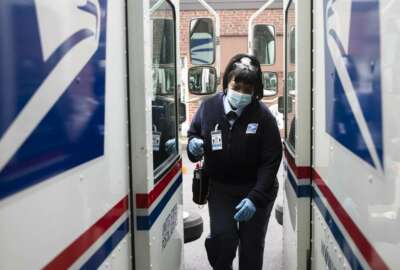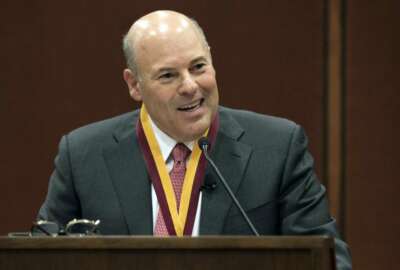
House-passed infrastructure bill gives USPS $25B for e-vehicles, facility updates
The Moving Forward Act would require USPS to replace its fleet of Grumman Long-Life Vehicles with at least 75% “electric or zero-emission vehicles.”
With or without the financial hit from the coronavirus, the Postal Service has warned Congress for years that it can’t sustain its current business model.
Lawmakers haven’t made much ground on passing long-term postal reform legislation, but House Democrats passed a $1.5 trillion infrastructure-spending bill Thursday that would give the Postal Service $25 billion to modernize postal infrastructure and operations. The bill specifies that $6 billion of that money would go toward buying a delivery vehicle fleet.
The Moving Forward Act would require USPS to replace its fleet of Grumman Long-Life Vehicles with at least 75% “electric or zero-emission vehicles.”
The bill would also require the agency to make at least 30% of its medium and heavy-duty vehicle fleet electric or zero-emission by 2030, and by 2040, the bill would prohibit the Postal Service from buying new non-electric or non-zero-emission vehicles.
House Committee on Transportation and Infrastructure Chairman Peter DeFazio (D-Ore.) said the infrastructure funding for USPS would help the agency meets its mission “rain, shine, night, day, COVID or not.”
“The Postal Service is doing it in 35-year old delivery vehicles. They’re decrepit and incredibly expensive to maintain. This would help them buy a new fleet and help them get through this crisis,” DeFazio said.
The Postal Service expects to have enough cash to keep operating through the end of this year — a more optimistic projection than what the agency forecasted earlier in the coronavirus pandemic —but without long-term reform, it predicts it could still run out of money before the end of 2021.
Read more: Congressional News
The House rejected an amendment from Rep. Jody Hice (R-Ga.), ranking member of the government operations subcommittee, that would strip the USPS funding from the bill. However, the amendment underscores growing skepticism from House Republicans that USPS needs any bailout.
The agency under normal circumstances doesn’t receive any annual funding from Congress.
“The reality is that over the last several months, the revenue trends no longer support the Postal Service’s multi-billion-dollar bailout request. This is because there’s much better numbers on performance that’s been driven by package volume,” Hice said.
USPS officials have given members of the House Committee on Oversight and Reform weekly updates on mail volume and revenue, and well as its cash on hand. With those figures in mind, Hice said giving USPS $25 billion to improve its infrastructure would be “simply premature.”
“We don’t need to go there at this point,” he said.
The CARES Act allows the Postal Service to borrow another $10 billion from the Treasury Department, but both agencies continue to negotiate over the terms of the loan.
However, Treasury Secretary Steven Mnuchin said last month that USPS doesn’t need the money because of a surge in package revenue. President Donald Trump has also threatened to hold up the loan unless USPS agrees to significantly raise package delivery rates for e-commerce giants such as Amazon.
Read more: Budget News
Republicans on the oversight committee have waited years for USPS to deliver a 10-year business plan. Former Rep. Mark Meadows (R-N.C.), now the White House chief of staff, expressed frustration with former Postmaster General Megan Brennan last year for not coming up with a plan sooner, despite the warning of an imminent financial crisis for the agency in the coming years.
While the coronavirus has exacerbated the Postal Service’s financial problems, the agency has ended the past 12 years with net financial losses. Among its financial struggles, a 2006 law requires the agency to pre-fund retiree health benefits.
The Government Accountability Office estimates USPS has defaulted on more than $48 billion in payments to that fund, which will run out of money by 2030.
Last month, logistics executive Louis DeJoy took over as postmaster general and outlined a “trajectory for success” for the agency amid its financial challenges. Hice said he expects DeJoy will make a long-term business plan a top priority during his tenure.
“Given the start of the new postmaster general’s term, we are hopeful that an update that outlines specific reforms to put the Postal Service on firm financial footing is going to happen. But absent revised estimates and a business plan, it is unclear what the true needs of the Postal Service are,” he said.
House Oversight Committee Chairwoman Carolyn Maloney (D-N.Y.) said the spending package would give USPS “critical funding” to keep operating.
“Despite better than expected revenue in recent months, the Postal Service is still at risk of running out of money. It could be forced to cease operations if it does not receive financial assistance from the federal government soon,” Maloney said.
Copyright © 2025 Federal News Network. All rights reserved. This website is not intended for users located within the European Economic Area.
Jory Heckman is a reporter at Federal News Network covering U.S. Postal Service, IRS, big data and technology issues.
Follow @jheckmanWFED





